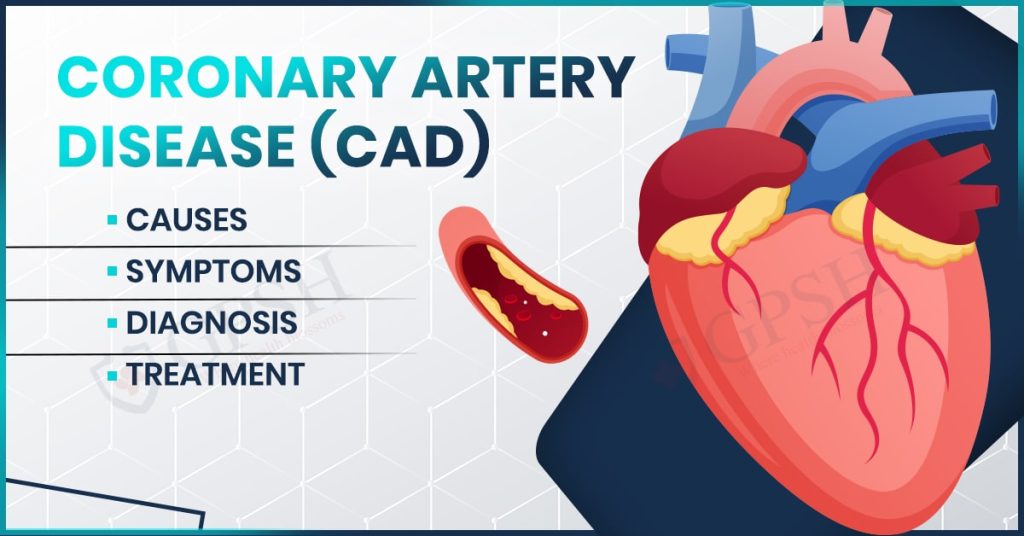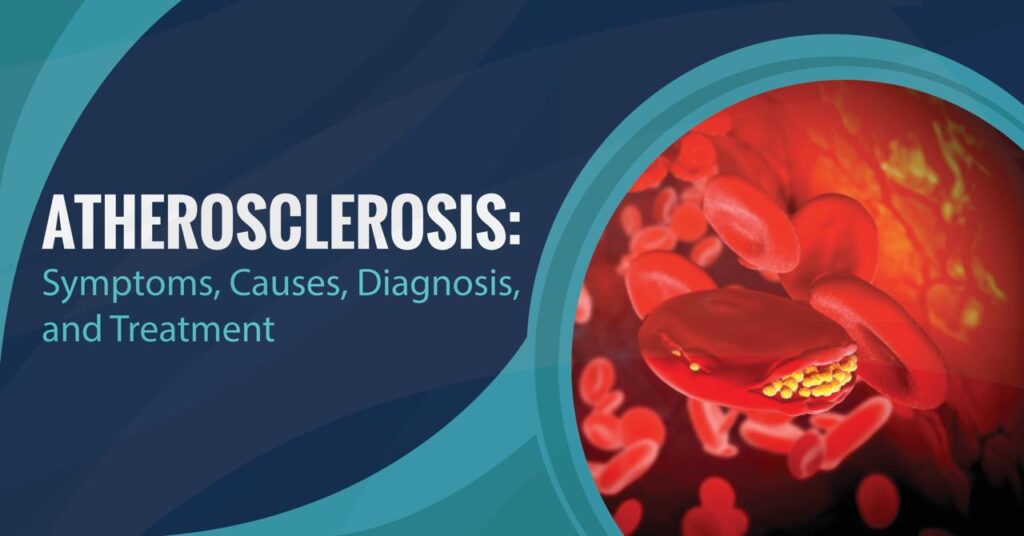Overview
Coronary Artery Disease (CAD) is a leading cardiovascular condition caused by the narrowing or blockage of coronary arteries due to atherosclerosis, which involves the buildup of cholesterol and other substances. This disease can result in severe complications, such as heart attacks. This article will examine the causes and risk factors of CAD, its common symptoms, the diagnostic methods used to identify it, and the various treatment options available, including lifestyle changes, medications, and surgical interventions. Understanding these aspects is vital for effective management and prevention of CAD.
What Causes Coronary Artery Disease (CAD)?
Coronary Artery Disease (CAD) is mainly caused by atherosclerosis, where fatty deposits, inflammatory cells, and scar tissue build up in the artery walls. This buildup forms plaques that narrow the coronary arteries, restricting blood flow to the heart. Key risk factors for CAD include high cholesterol, high blood pressure, smoking, diabetes, obesity, lack of physical activity, and a family history of heart disease. Additional factors such as age, gender, and certain inflammatory conditions can also contribute. Over time, reduced blood flow may lead to ischemia (insufficient oxygen to the heart), causing symptoms like angina (chest pain) or even a heart attack.
You can read also:- Benign Prostatic Hyperplasia – Causes, Symptoms, Diagnosis and Treatment
Types of Coronary Artery Disease
Coronary Artery Disease (CAD) can be categorized into several types based on the specific characteristics of the arterial blockages and their clinical implications. Here are the main types:
- Stable Angina: This type is characterized by predictable chest pain or discomfort that occurs with exertion or stress and is relieved by rest or medication. It is often a sign of narrowed arteries but does not usually lead to a heart attack.
- Unstable Angina: This type is more severe and unpredictable, occurring at rest or with minimal exertion. Unstable angina may last longer and is not easily relieved. It signifies a higher risk of heart attack and requires immediate medical attention.
- Myocardial Infarction (Heart Attack) occurs when blood flow to a part of the heart is blocked for an extended period, damaging or killing heart muscle tissue. It can result from unstable angina or a complete blockage of a coronary artery.
- Silent Ischemia: In this type, the patient experiences reduced blood flow to the heart without noticeable symptoms. This can be particularly dangerous, as it may go undetected until serious complications arise.
- Coronary Microvascular Disease: This type affects the small blood vessels within the heart and can lead to chest pain or discomfort similar to other forms of CAD. It may occur even when larger coronary arteries appear normal.
- Variant (Prinzmetal’s) Angina: This is a rare type of angina caused by spasms in the coronary arteries, which temporarily restrict blood flow. It can occur at rest and often happens at night.
Stages of Coronary Artery Disease
Coronary Artery Disease (CAD) progresses through several stages, each marked by distinct changes in the coronary arteries and varying degrees of symptoms. Here are the key stages:
- Normal Arteries: In this initial stage, the coronary arteries are healthy and functioning properly, with no significant blockages or atherosclerotic changes.
- Fatty Streaks: The first visible sign of CAD, this stage involves the accumulation of lipids (fats) in the arterial walls. These streaks are typically found in the inner layer of the arteries and may not cause any symptoms.
- Atheroma Formation: Over time, fatty streaks develop into more complex lesions called atheromas or plaques. These plaques consist of lipids, inflammatory cells, and fibrous tissue, leading to arterial narrowing and potential restriction of blood flow. Symptoms may begin to occur, particularly during physical activity or stress.
- Stable Plaque: In this stage, the plaques are stable and may not significantly obstruct blood flow. Patients may experience stable angina, which is characterized by predictable chest pain or discomfort during exertion that resolves with rest.
- Unstable Plaque: Plaques become unstable and may rupture, leading to the formation of a blood clot. This stage is critical, as it can result in unstable angina or a myocardial infarction (heart attack). Symptoms can become more severe and unpredictable.
- Acute Coronary Syndrome (ACS): This stage encompasses conditions resulting from sudden reduced blood flow to the heart, including unstable angina and myocardial infarction. Symptoms can include severe chest pain, shortness of breath, and sweating, requiring immediate medical attention.
- Chronic CAD: If CAD progresses without effective management, patients may enter a chronic stage characterized by persistent symptoms, such as angina, and an increased risk of heart failure or other cardiovascular complications.
Symptoms of Coronary Artery Disease
The symptoms of Coronary Artery Disease (CAD) can vary depending on the severity of the condition and the extent of arterial blockage. Here are the most common symptoms associated with CAD:
- Chest Pain (Angina): This is the most common symptom and can feel like pressure, squeezing, fullness, or pain in the center or left side of the chest. Angina may occur during physical activity, stress, or after eating and typically resolves with rest.
- Shortness of Breath: Difficulty breathing or shortness of breath may occur, especially during physical exertion or while lying down, indicating that the heart is not receiving enough blood.
- Fatigue: Unusual tiredness or fatigue can occur, especially during physical activities, as the heart struggles to pump adequate blood to meet the body’s demands.
- Heart Palpitations: Individuals may experience sensations of a rapid or irregular heartbeat, often associated with stress or physical exertion.
- Dizziness or Lightheadedness: Some people may feel dizzy or faint, especially during physical activity, due to inadequate blood flow to the brain.
- Nausea or Indigestion: These symptoms can sometimes accompany chest pain, leading to confusion about whether the discomfort is related to the heart or digestive system.
- Radiating Pain: Pain may radiate to other areas, including the arms (especially the left arm), shoulders, neck, jaw, or back. This can happen during angina episodes or heart attacks.
- Sweating: Excessive sweating, often described as “cold sweats,” can occur during angina or a heart attack.
You can read also:- Asbestosis: Causes, Symptoms, Diagnosis, Risk Factors and Treatment
Causes of Coronary Artery Disease
Coronary Artery Disease (CAD) is primarily caused by a combination of risk factors that contribute to the development of atherosclerosis, the buildup of plaques in the coronary arteries. Here are the main causes and risk factors associated with CAD:
- Atherosclerosis: The primary underlying cause of CAD, atherosclerosis involves the accumulation of cholesterol, fats, and other substances in the arterial walls, leading to plaque formation that narrows and hardens the arteries.
- High Cholesterol Levels: Elevated levels of low-density lipoprotein (LDL) cholesterol (often referred to as “bad” cholesterol) can contribute to plaque buildup, while low levels of high-density lipoprotein (HDL) cholesterol (the “good” cholesterol) may increase risk.
- Hypertension (High Blood Pressure): Chronic high blood pressure can damage blood vessels and accelerate the development of atherosclerosis.
- Smoking: Tobacco use damages the lining of blood vessels, promotes plaque formation, and decreases oxygen in the blood, significantly increasing the risk of CAD.
- Diabetes Mellitus: Diabetes contributes to CAD through various mechanisms, including high blood sugar levels that can damage blood vessels and increase the likelihood of plaque buildup.
- Obesity: Excess body weight, particularly abdominal fat, is associated with increased levels of LDL cholesterol, hypertension, and insulin resistance, all of which elevate the risk of CAD.
- Unhealthy Diet: Diets high in saturated fats, trans fats, cholesterol, and refined sugars can contribute to obesity, high cholesterol, and high blood pressure, increasing the risk of CAD.
- Family History: A genetic predisposition to heart disease can significantly impact an individual’s risk of developing CAD. A family history of early heart disease increases this risk.
- Chronic Inflammation: Conditions associated with chronic inflammation, such as rheumatoid arthritis or lupus, may also increase the risk of CAD.
Diagnosis of Coronary Artery Disease
Diagnosing Coronary Artery Disease (CAD) involves a combination of medical history evaluation, physical examinations, and various diagnostic tests to assess the condition of the coronary arteries and the heart’s overall health. Here are the common methods used in the diagnosis of CAD:
- Medical History: The healthcare provider will take a detailed medical history, including information about symptoms, risk factors (such as family history, smoking, and lifestyle), and any existing medical conditions.
- Physical Examination: A thorough physical examination may involve checking blood pressure, listening to the heart, and assessing overall health to identify any signs of heart disease.
- Electrocardiogram (ECG or EKG): This test records the electrical activity of the heart and can reveal irregular heart rhythms, signs of previous heart attacks, or other heart-related issues.
- Stress Testing: A stress test evaluates how the heart functions under physical stress. Patients may exercise on a treadmill or stationary bike while heart rate, rhythm, and blood pressure are monitored. If exercise is not possible, medication may be used to simulate the effects of exercise on the heart.
- Echocardiogram: This ultrasound test provides images of the heart’s structure and function. It can help detect abnormalities in heart walls and assess blood flow.
- Coronary Angiography: This invasive procedure involves injecting a contrast dye into the coronary arteries through a catheter. X-ray images are taken to visualize any blockages or narrowing in the arteries.
- Computed Tomography (CT) Angiography: A non-invasive imaging technique that uses CT scans to create detailed images of the coronary arteries. It can help identify blockages and assess the extent of CAD.
- Cardiac Magnetic Resonance Imaging (MRI): This imaging test provides detailed images of the heart’s structure and function and can help identify areas of reduced blood flow or damage.
- Blood Tests: Blood tests may be performed to check cholesterol levels, blood sugar levels, and markers of inflammation (such as C-reactive protein), which can indicate an increased risk of CAD.
- Coronary Calcium Scan: This specialized CT scan measures the amount of calcium deposits in the coronary arteries, which can indicate the presence of atherosclerosis and help assess the risk of heart disease.
Risk Factors of Coronary Artery Disease
The risk factors for Coronary Artery Disease (CAD) can be categorized into modifiable and non-modifiable factors. Understanding these risks is essential for prevention and management. Here are the key risk factors:
-
Modifiable Risk Factors
- High Cholesterol: Elevated LDL and low HDL cholesterol contribute to plaque buildup.
- Hypertension: High blood pressure damages blood vessels and accelerates atherosclerosis.
- Smoking: Tobacco use harms blood vessels and increases plaque formation.
- Diabetes: Poorly controlled diabetes damages blood vessels and increases atherosclerosis risk.
- Obesity: Excess weight, especially abdominal fat, is linked to higher cholesterol and blood pressure.
- Physical Inactivity: A sedentary lifestyle contributes to obesity and other risk factors.
- Unhealthy Diet: Diets high in unhealthy fats and sugars raise the risk of CAD.
- Excessive Alcohol: Heavy drinking can lead to high blood pressure and weight gain.
- Chronic Stress: Long-term stress may result in unhealthy behaviors and negatively affect heart health.
-
Non-Modifiable Risk Factors
- Age: Risk increases with age (over 45 for men, over 55 for women).
- Gender: Men are at higher risk at a younger age; women’s risk increases after menopause.
- Family History: A family history of heart disease raises an individual’s risk.
- Genetics: Certain genetic factors can predispose individuals to CAD.
Treatment of Coronary Artery Disease
The treatment of Coronary Artery Disease (CAD) aims to manage symptoms, improve quality of life, and reduce the risk of complications, such as heart attacks. Treatment approaches can be divided into lifestyle changes, medications, and medical procedures. Here are the main treatment options:
-
Medications
- Antiplatelet Agents: Aspirin or other antiplatelet medications help prevent blood clots from forming in narrowed arteries.
- Statins: These medications lower cholesterol levels and reduce the risk of plaque buildup in the arteries.
- Beta-Blockers: These help lower blood pressure and heart rate, reducing the heart’s workload and relieving angina.
- ACE Inhibitors: These medications help lower blood pressure and improve blood flow, particularly in individuals with heart failure or diabetes.
- Calcium Channel Blockers: These can help relieve angina by relaxing blood vessels and improving blood flow.
- Nitrates: Used to relieve angina by dilating blood vessels and improving blood flow to the heart.
-
Medical Procedures
- Angioplasty and Stenting: A minimally invasive procedure that opens narrowed coronary arteries using a balloon and places a stent to keep the artery open.
- Coronary Artery Bypass Grafting (CABG): A surgical procedure that involves creating a bypass around blocked arteries using grafts from other parts of the body to restore blood flow to the heart.
- Coronary Atherectomy: A procedure that removes plaque from the arteries to improve blood flow.
Conclusion
In conclusion, Coronary Artery Disease (CAD) is a significant cardiovascular condition that can lead to serious health complications if not managed effectively. Early diagnosis and a comprehensive treatment plan—encompassing lifestyle changes, medications, and medical procedures—are crucial for improving patient outcomes. CAD falls under the cardiology department, where specialized care is essential. Shekhawati Hospital is renowned for its expertise in diagnosing and treating CAD, providing patients with the necessary support for effective management and recovery.









